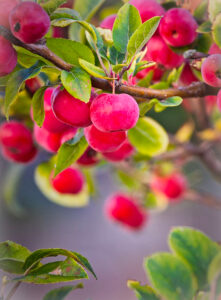
Pruning is a complex subject. The following are just a few of the things to consider.
Trees respond differently to pruning at different times of the year and to where cuts are made. Humidity, hygiene, timing, insect pressure, root stocks, aspect, vigor, desired shape and height all are factors that affect decisions of how and when to prune.
Pruning is a very intuitive process,”Touch Trees”, feel that trees are living organisms, get to know your subjects. They all have different growth patterns to observe. Work with the natural form the trees possess.
Be a good investigator, take your time, pay attention to details, do a good job, educate yourself.
WHY TO PRUNE
- Control size
- Reinvigorate old wood to productive wood
- Decrease vigor, issue new responses at cut site
- Increase fruit spurs and thin fruiting wood
- Open up canopy for better light penetration and air circulation
- Remove weak crotch angles
- Remove competing branches
- Remove co dominate branching, crossing, and dead branches
- Remove interior non fruiting and marginal fruit sites( fruit spurs growing below branches)
- No sealers or paint on any cut surface ever
- Pruning influences fruit quality, balances vegetative growth with fruit load
GENERAL RULES
- Don’t remove lower branches too early, lower branches aid in trunk flair, good anchorage, and branch development
- Seedling trees usually need less or very little pruning to maintain a natural habit
- Clonal rootstock tend to need more maintenance due to tendencies to produce more branches that want to grow vertical
- Spur types need very little training, thinning, or heading
- Pruning is a dwarfing process, increases vegative growth, stimulates wood replacement, and reinvigorates tired low productive wood
- Pruning reduces yield, removal of wood with flower buds reduces potential fruit,
- Yields are less but quality is improved by size.
- Weight load to scaffold is reduced- especially important in young trees
- Never Top an established tree to lower size!
- Pay attention to natural tree shapes, try to work with what the tree wants to do.
- In most cases you can follow up with pruning that complements natural branching rather than making them do what they may not want to do.
- Never remove a branch or twig without having a reason to do so.
- Tool hygiene; clean, sharp, keep off the ground, wipe or spray with 90 percent alcohol, approved bactericides and fungicides, or 5% bleach and water
- Pick up and remove the cut branches and twigs.
TYPES OF CUTS
- Pruning is; Thinning, Heading ,bench cuts, notching to increase or decrease bud vigor
- Thinning cuts; removal of competing branches and twigs, opens up light and air
- Heading cuts; reduce apical dominance, reduce length, control height and width, send new vigor to the next 3 to5 buds below the cut to direct growth to spurs
- Never make flush cuts, they callus improperly and increase decay surface area
- Avoid stub cuts, final cuts should be at collar or Branch Bark Ridge
TIMING OF PRUNING
- Things that flower first, get pruned last; late in the dormant season or very early in the spring before bud break
- Heavy pruning in the growth flush, and before leaf drop in the fall should be avoided
- No more than ¼ of the trees canopy should be removed per season
- Young trees can respond to heavy pruning better than established trees
- Trees don’t heal, they seal. Cutting wood at any time stimulates cell activity at the cut site to compartmentalize cell walls to seal out infection
- Early winter pruning can cause winter damage and interrupt dormancy clock, even cause some species to break bud too soon
DORMANT SEASON PRUNING
- Dormant pruning stimulates wood replacement, don’t remove a branch unless you have a reason and make yourself aware of the response the tree will make at that site
- As late in the winter as possible can aid in preventing premature bud break and fruit loss
- Pruning delays fruiting, unpruned trees will flower and fruit sooner
- One to four old trees should not be pruned too much in winter for these reason
SUMMER PRUNING
- Summer pruning encourages spur formation and can lessen watersprout competition in trees that are heavily pruned or have an umbrella formation
- Summer pruning reduces canopy and root growth due to loss of leaf surface, can affect trunk flair and retard vigor in young trees, and delay fruiting
- Summer pruning stiffens branches so use caution when pruning narrow crotch angles that will eventually be pushed out with limb spreaders, since this can cause included bark which is more prone to splitting
- One to four old trees should not be pruned too much in summer for these reasons
- Summer pruning can help bring biennial croppers into a more annual cycle
SUGGESTED READING
Mycorrhizal Planet, The Holistic Orchard and The Apple Grower by Michael Phillips
The Grafters Handbook by R. J. Garner
Rodale’s Guide to Organic Growing by Rodale Press
Fruit, Nut and Berry Inventory by Seed Savers Exchange
Organic Orcharding by Gene Logsdon
Any book or article by Alex Shigo
A Tree Hurts, Too
Tree Anatomy
Tree Pruning Basics
100 Tree Myths
Tree Pithy Point
Modern Arboriculture: A Systems Approach to the Care of Trees and Their Associates
Tree Pruning: A Worldwide Photo Guide
Tree Basics: What Every Person Needs to Know About Trees
A New Tree Biology Dictionary Terms, Topics, and Treatments for Trees and Their Problems and Proper Care
A New Tree Biology: Facts, Photos, and Philosophies on Trees and Their Problems and Proper Care

